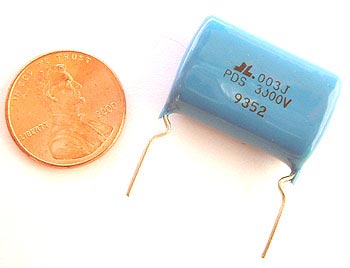Just a little note on my latest learning experience at the scool of hard knocks.
I used a corrective/conjunctive filter in my last design, a 2 x el84 amp. By my figures with a 1500pf cap and 10k resistor I used a 600V rating for the cap (350 plate volts) and a 5 watt resistor. Well...It burned up. It didn't take any other parts with it, so thats good. But considering the voltage spikes at these higher frequencies these parts were clearly underrated. As evidenced by the fact that my capacitor is now a dead short and my resistor got so hot with that cap shorted that it melted the insulation on a nearby lead wire. With some research I read that these spikes can be two or three times the plate voltage. A regular 600V film cap failed horribly.
So if you decide to use a conjunctive/ corrective filter, take the high ground and use generaously overrated parts and don't locate them near anything heat sensitive.
My new parts are a 1KV mica "snubber" cap and a 10W cement resistor... I don't anticipate any more problems.
Chuck
I used a corrective/conjunctive filter in my last design, a 2 x el84 amp. By my figures with a 1500pf cap and 10k resistor I used a 600V rating for the cap (350 plate volts) and a 5 watt resistor. Well...It burned up. It didn't take any other parts with it, so thats good. But considering the voltage spikes at these higher frequencies these parts were clearly underrated. As evidenced by the fact that my capacitor is now a dead short and my resistor got so hot with that cap shorted that it melted the insulation on a nearby lead wire. With some research I read that these spikes can be two or three times the plate voltage. A regular 600V film cap failed horribly.
So if you decide to use a conjunctive/ corrective filter, take the high ground and use generaously overrated parts and don't locate them near anything heat sensitive.
My new parts are a 1KV mica "snubber" cap and a 10W cement resistor... I don't anticipate any more problems.
Chuck


 . FWIW the cap I had in the circuit (that had all it's innards welded together) was a 600V 715P.
. FWIW the cap I had in the circuit (that had all it's innards welded together) was a 600V 715P.
Comment